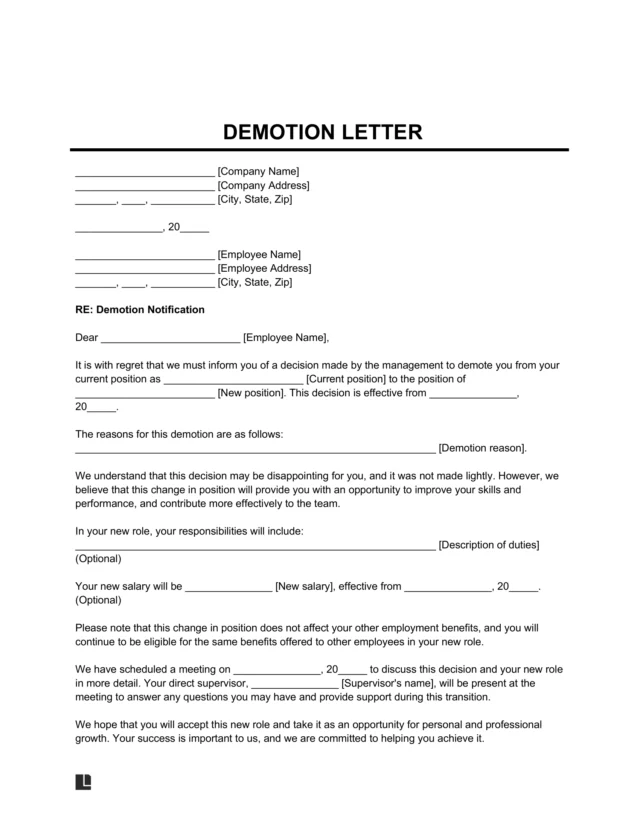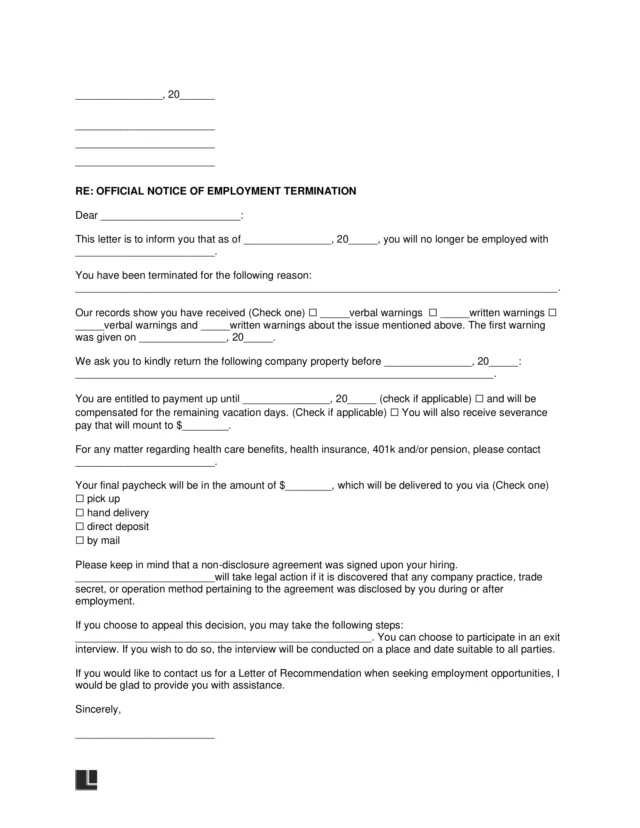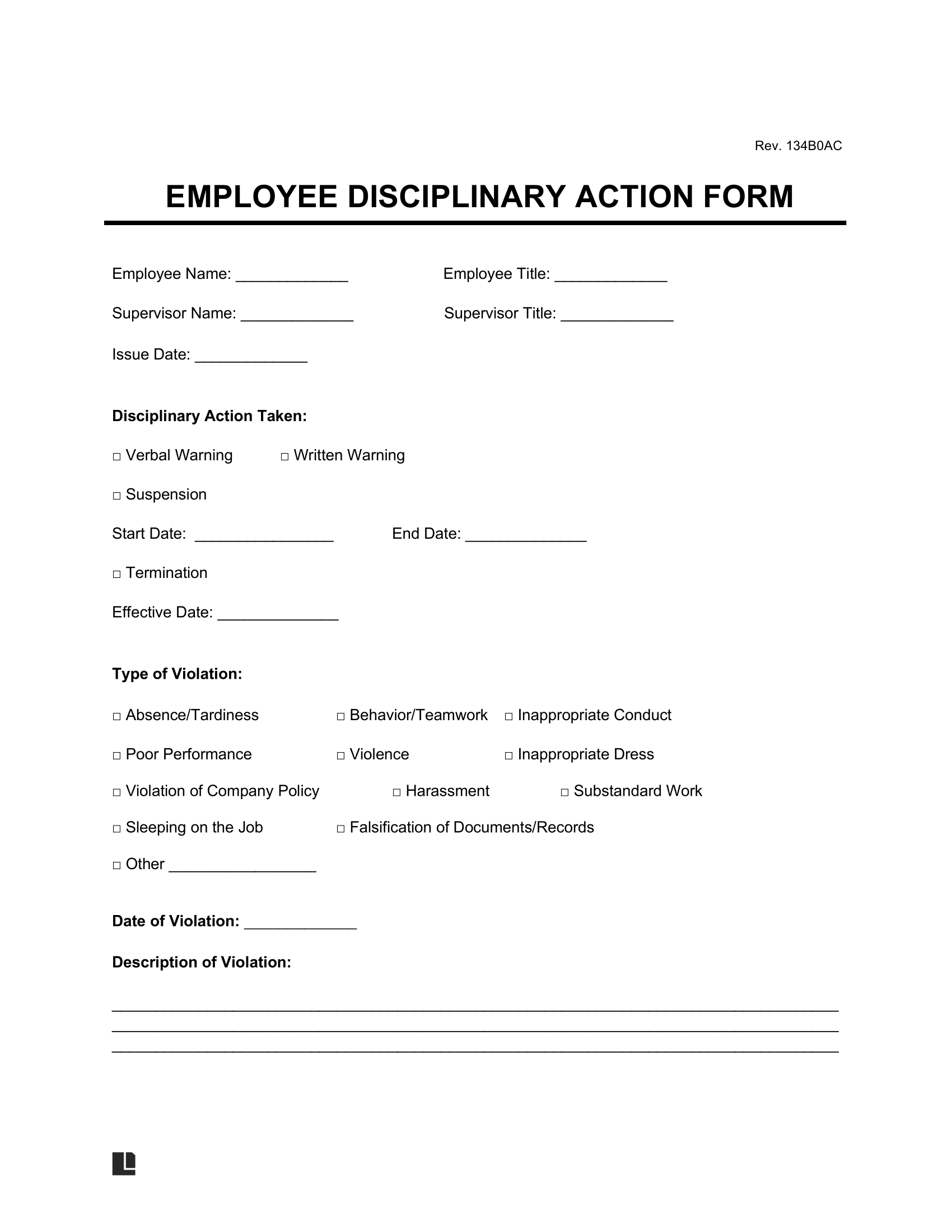What Is an Employee Disciplinary Action Form?
An employee disciplinary action form is a document showing the consequences of misconduct. It includes information about the employee’s behavior, company policies, and corrections. Typically, a human resources professional writes this form.
An employee warning notice is the first step, often applicable to first-time or minor issues. If the employee repeats their behavior or commits a serious violation, take disciplinary action. This helps you respond more firmly when the situation calls for it.
A disciplinary form helps keep things fair, solves problems consistently, and keeps a written record. Legal Templates’ form includes helpful details to manage behavior at work.
When to Use a Disciplinary Action Form
A disciplinary action form is used to fix problems at work. You can write it when an employee breaks a rule or does something wrong. Some common causes for using this form are:
- Safety violations: Not following safety rules, which can cause harm or introduce liability.
- Inappropriate conduct: Violating company policies, such as the harassment policy.
- Poor performance: Not doing the job right, not reaching goals, or not finishing tasks.
- Frequent absences: Missing work often or not showing up without a good reason or telling anyone.
- Late arrivals: Frequently late to work or meetings without valid reasons.
- Procedural violations: Noncompliance with company procedures, guidelines, or protocols.
What Are the Forms of Disciplinary Action?
Disciplinary processes and actions take on many forms. The most common types include:
- Verbal warning: Talk to help everyone understand the issue and explain what could happen if it continues.
- Written warning: Use an employee reprimand, write-up, or employee discipline form to record issues.
- Suspension: Take the employee away from work for a short time to look at and fix their behavior.
- Termination letter: Inform an employee that their employment has ended.
Our template lets you add your own disciplinary action plan to fix employee behavior. You can change the form to fit your needs and company rules.
What to Include in an Employee Disciplinary Action Form
When filling out an employee disciplinary action form, it’s important to include all the right details. Here’s what to add to make sure the form serves its purpose:
- Issue date: Include the date you issue the form for an accurate timeline.
- Employee information: Provide the name and job title of the recipient.
- Supervisor information: Note the name and job title of the affected employee’s supervisor.
- Violation subject: Identify the most relevant subject of the incident.
- Incident date: Add the date on which the reported situation occurred.
- Violation description: Describe the employee’s behavior and any witness accounts.
- Discipline plan: Choose a write-up form, suspension, demotion form, or termination letter.
- Employee statement: Allow space for employees to comment or explain their behaviors.
- Follow-up procedure: Arrange a follow-up meeting to check progress and confirm goals.
Our employee disciplinary action form takes you through every step of the process. These elements ensure consistent records and valid evidence to protect against disputes.
How to Discipline an Employee
Knowing how to discipline an employee helps foster a fair and positive environment. Consider other options and then create and follow up on the employee’s progress.
1. Consider Other Measures First
Consider other corrective measures, like a verbal warning, open discussion, or warning notice. These alert employees of their mistakes and provide more room for independent improvement. You can also provide an employee corrective action form to support changes in behavior or performance.
Using an alternative for less severe situations makes the process less stressful. Plus, it may resolve issues before they worsen.
2. Write a Disciplinary Action Form
If you decide to apply a disciplinary action, it’s time to start writing the form. Record the violation with a reference to the employee handbook or company policy. Describe the situation with accounts of what the employee did or said.
Also, include an overview of the correction plan and consequences for noncompliance. Allow the employee to explain their perspective and have them sign the document. Consider offering the employee a notice of disciplinary action so they can prepare their response.
3. Follow Up With the Employee
Follow up with the employee and ask them to describe their corrective actions. Ensure they complete their tasks and provide support as needed. If necessary, create a new plan for employees who struggle to meet their goals.
How to Write an Employee Disciplinary Form
When creating an employee disciplinary action form, follow these steps to provide clarity and safeguard your organization’s interests:
1. Cover Identifying Information
Include a section with details such as the employee’s name, title, direct supervisor’s name, and the date of the incident. This provides crucial information for future review.
2. Clearly State the Violation
Add a detailed account of the disciplinary action involved. Specify whether it is a verbal or written warning, suspension, or any other long-term action. Include start and end dates for any suspensions, and provide checkboxes for supervisors to indicate the type of violation.
3. Be Specific
Allocate sections for additional context to help others understand the incident. Allow space to describe the violation in the reporter’s own words. Provide room to outline the corrective plan, consequences for failure to improve, and an employee statement. Establish a timeline for potential follow-ups on disciplinary action.
4. Signatures and Dates
Designate a space for the employee receiving the disciplinary action and their supervisor to sign and date the form.
Sample Employee Disciplinary Action
View a free sample of an employee disciplinary action form. This provides an idea of the information necessary to make it as effective as possible. Download our sample in PDF or Word format.
Legal Considerations for Taking Disciplinary Action
Disciplinary action written forms protect employers from wrongful termination or unfair treatment claims. The legal implications require the company to consider legal aspects such as:
- Employment laws: Follow labor codes, anti-discrimination laws, and employment contracts.
- Consistent treatment: Discipline all employees and document issues in the same manner.
- Clear policies: Establish and communicate procedures outlining expected behavior and consequences for misconduct.
- Due process: Conduct fair investigations, allowing employees to respond or provide context.
- Valid documentation: Keep records, including written warnings and evaluations.
- Appeal opportunities: Provide an appeals process to review decisions disputed by employees.
- Legal counsel: Seek guidance from employment law experts in complex cases or situations.
How Legal Templates Helps with Disciplining Employees
Legal Templates offers a disciplinary action template to help you discipline employees. Our lawyer-approved template makes improving compliance and fostering a positive work environment easy. With our fair, consistent, and detailed template, you won’t have to sweat the details.
Frequently Asked Questions
What are the best practices for completing an employee disciplinary action form?
Best practices include remaining factual, unbiased, and consistent. Follow company policies, gather facts, outline issues, and provide solutions. Also, ensure the affected employee can comment, respond, and acknowledge the disciplinary plan.
What is unfair disciplinary action?
Unfair discipline happens when the punishment doesn’t match the problem or is done for personal or biased reasons. Talking to HR and focusing on the facts can help avoid unfair actions.
Can I implement disciplinary action without first issuing a warning?
You can implement a disciplinary action without an initial warning. Common causes include repeat offenses, serious misconduct, and at-will employment agreements. It’s essential to remain consistent and follow established procedures.
Can an employer disclose disciplinary action against an employee?
In most cases, an employer should not disclose disciplinary actions to others. However, legal proceedings or subpoenas may require the employer to share this information.





